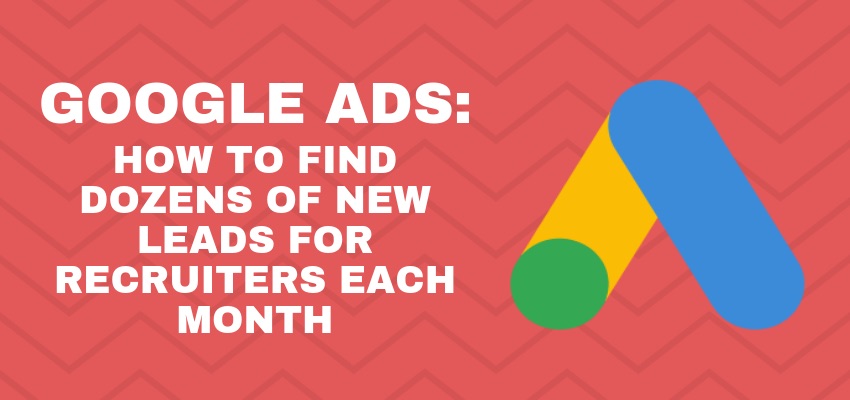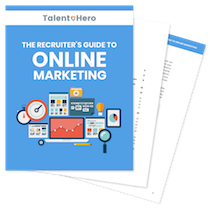As much as you hate to admit it, you’ve clicked on the ads at the top of Google searches. While we like to pretend that we always go straight to the regular search results, the data shows this isn’t true.
Google earned $17.4 billion in Q1 2017 from ad sales alone so we can be certain that these ads are more effective than most people believe.
Why does this matter to recruiters? Because if you know what you’re doing, you can use Google Ads (formerly Google AdWords) to find new clients immediately at a cost that is highly reasonable.
What is Google Ads?
Google Ads is a tool that lets you buy ad space at the top of Google search results and in Google’s display network (partner sites that Google pays to display their ads). For this article, we’re going to focus exclusively on Google search.
How can a recruiter use Google Ads?
We all know that hiring managers and other executives use Google to find recruiters. In our first post on SEO for recruiters, we saw that, for example, there are at least 4,250 queries per month for retail recruiters alone. This means that if you buy an ad for your retail recruiting business at the top of all of these search queries, you will have a minimum of 4,250 opportunities per month to generate new leads.
What does this mean in practice? If we assume that your ad will get clicked around 2% of the time (the industry average), you will have to pay $5 per click and that 10% of the people who land on your site will contact you, you can get about 9 new leads per month for only $425! Compare this to your other customer acquisition methods and you’ll immediately see that this is an easy win.
How does Google Ads work?
At its most basic, Google Ads is a pretty simple tool. You tell Google what keywords you want to display ads for and how much you’re willing to pay every time someone clicks on your ad. When a user enters the keywords you want to show an ad for, Google performs an instantaneous live auction between you and your competition and whoever has agreed to pay the most for a click gets the top spot with the remaining spots allocated to the people paying lower bids.
For example, for the term “science recruiter”, Scientific Search has agreed to pay the most followed by Kelly Services.
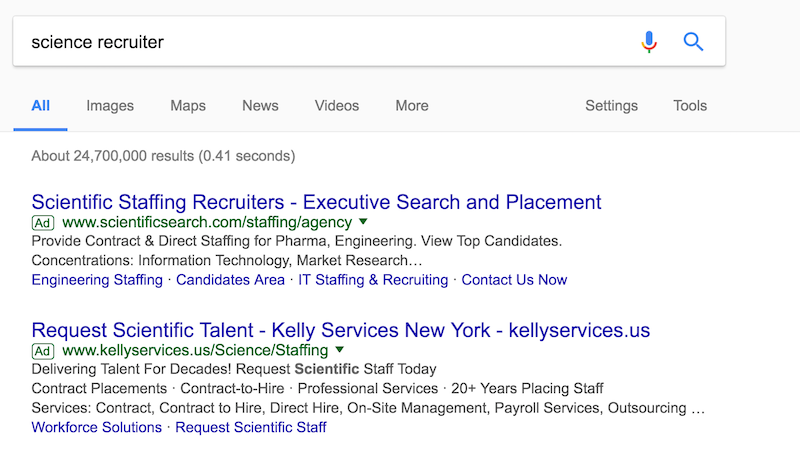
For the term “IT recruiter”, we see four different companies bidding for the highly competitive term.
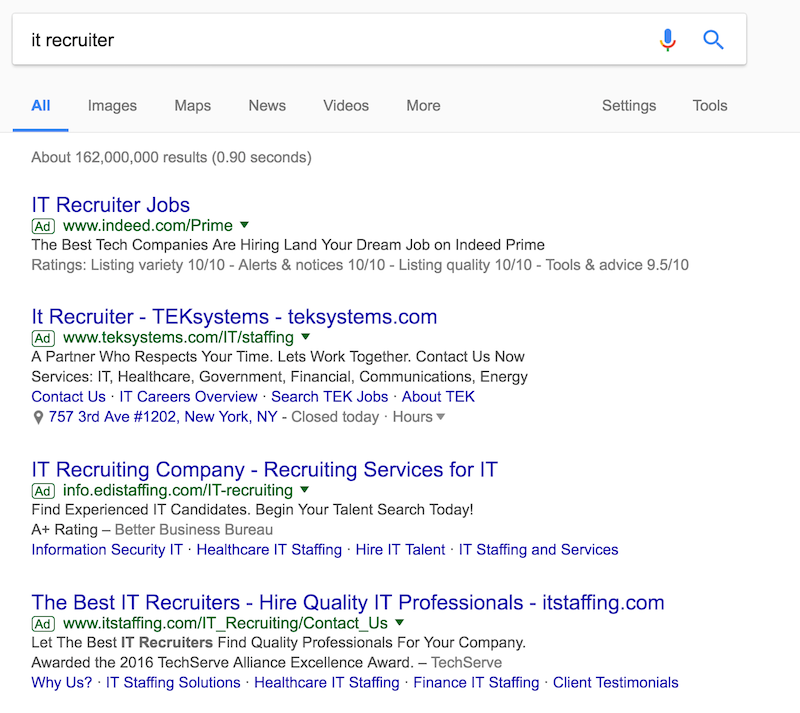
It can’t be this easy, right?
While it is easy to understand the basics of Google Ads, it is much more difficult to create a campaign that is cost-effective.
If you’re going to go down the Google Ads path without the help of a trained professional, here are some things to consider.
Your match type is critical to keeping your costs down
By default, when you enter the keywords you want to bid for, you are using a broad match type. This means that Google decides the intent of your keyword and will typically place you in auctions for many more keywords than would be effective.
For example, if I enter “retail recruiter” as my keyword, I am going to end up bidding not only on people looking for my retail recruiting business but also for people looking for jobs in retail clothing stores. Obviously, this type of mismatch between what you want to pay for and what you are actually paying for can get expensive fast.
To get around this problem, make sure you use the phrase match type. By putting your keywords in square brackets (like this [retail recruiter]), Google knows that it is only allowed to show ads to people who have explicitly entered the term “retail recruiter” in their search.
Understand your Quality Score
In the simple example above, I said that AdWords operates as an instantaneous live auction where the highest bidder wins. In reality, it’s a lot more complicated than that.
Google wants to make sure that the ads they show are relevant to the user and that the experience after the person clicks the ad is high-quality. Therefore, every keyword in your account is assigned a Quality Score from 1 to 10. As Google states, “[h]igher quality ads can lead to lower prices and better ad positions”. In other words, if your keyword has a Quality Score of 8 and your competitor has a Quality Score of 2, your ad may show up higher even if you have set a lower bid for the same keyword.
As you can see, Quality Score can make a huge difference to the success of your campaign so you want to make sure that you get the highest score possible. How do you do that? Focus on optimizing expected clickthrough rate and landing page experience.
Expected clickthrough rate
Every time someone sees your ad and clicks on it, your click-through rate goes up. Every time they don’t, it goes down. As you can imagine, a high click-through rate is therefore a great signal to Google that you’ve created an ad that people find helpful. There are many ways to increase click-through rate but one you should understand is search query to ad text match. When people see their search query in your ad, i.e., the words they typed in the search box in the ads that are displayed, they are much more likely to deem it to be useful and click on it. Furthermore, Google will highlight your search query in bold when it appears in your ad text, making it stand out that much more.
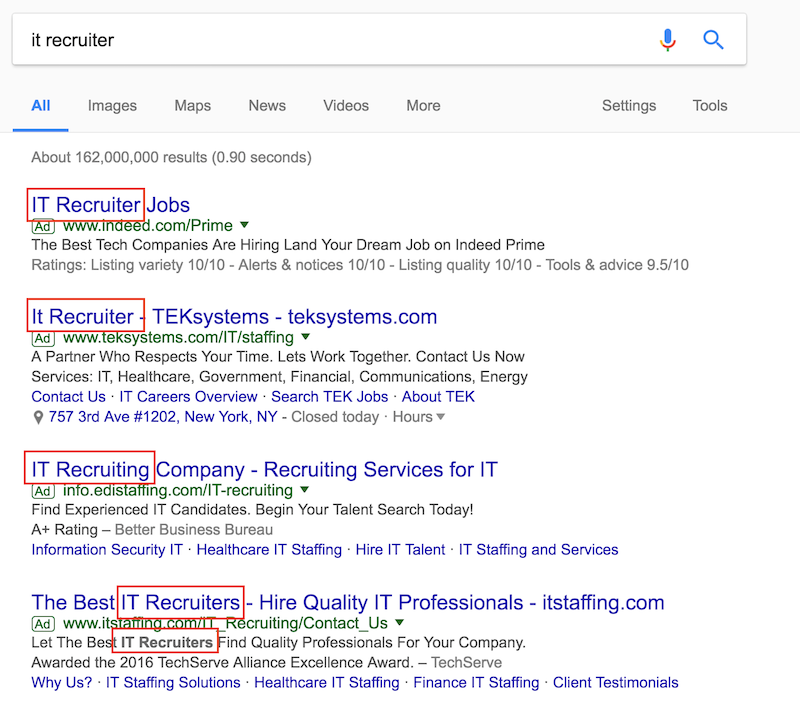
In practice, this means that you should create highly customized ads for your search queries. Do not take a one-sized-fits-all approach.
Landing page experience
When someone clicks on your ad, the page they are taken to is called the landing page. Google wants to make sure that even after the user has left Google to go to your site, the quality of the user experience remains high. How do you do that?
- Make sure that your landing page has a clear purpose. In short, don’t direct people to your business home page. Send them to a page that is directly related to the ad and gives them a clear call-to-action like “contact us to learn more”.
- Make sure your landing page has text that matches your keywords. Google will crawl your landing page and make sure that it is relevant to your keywords and ads. The number one method for determining relevancy is a good match between your keywords, ads and landing page. For example, if you are an IT recruiter and you are bidding on the term “executive search IT recruiter”, make sure that your ad and landing page have that exact phrase in at least one spot.
- Use your ad text on your landing page. When a user clicks an ad and then they see the exact same ad text on the landing page, they know they have come to the right place and are much likelier to explore further, improving their landing page experience.
Carefully track your results
Google Ads allows you to track the performance of every keyword for which you are bidding by using conversions. For example, if someone fills out a form on your landing page or calls you after landing on the page, Google Ads can tell you the exact keyword they used to find your business. Over time, you can build up a huge dataset showing your most effective keywords and you can adjust your bids accordingly.
Unfortunately, by default, none of this is set up so most people have very little idea as to what is working and what isn’t. Don’t be left in the dark!
Google Ads is a complex beast
Google Ads can be a highly powerful tool for running effective ads to find new clients for your recruiting business but at the same time, it has a very steep learning curve. If you’re willing to do the research by reading dozens of blog posts, you certainly can figure it out but if that doesn’t interest you, contact a trained professional before you get started.

